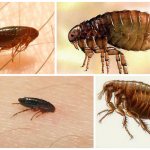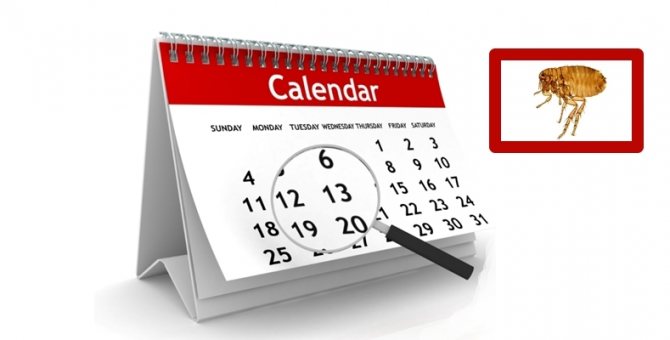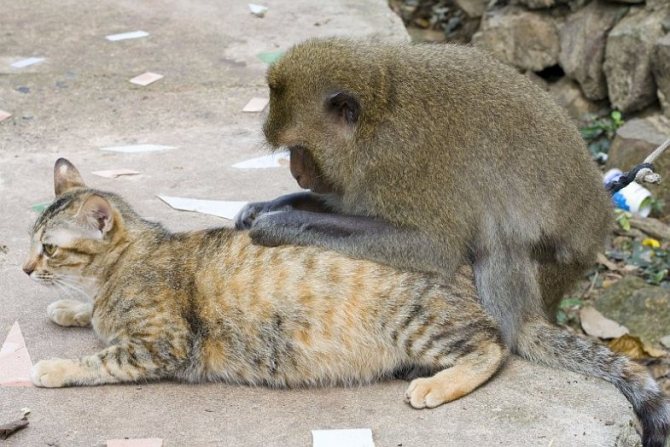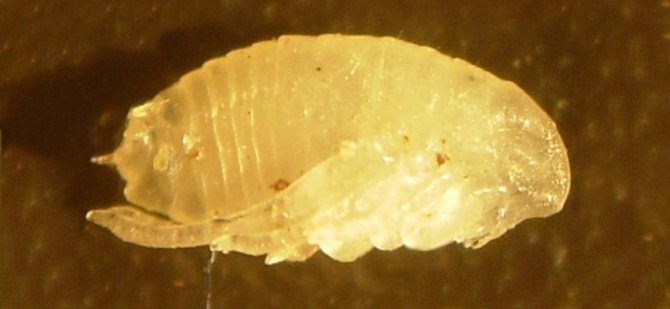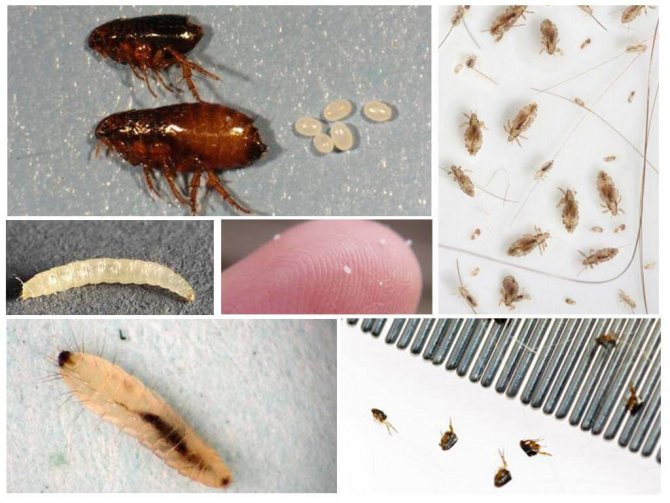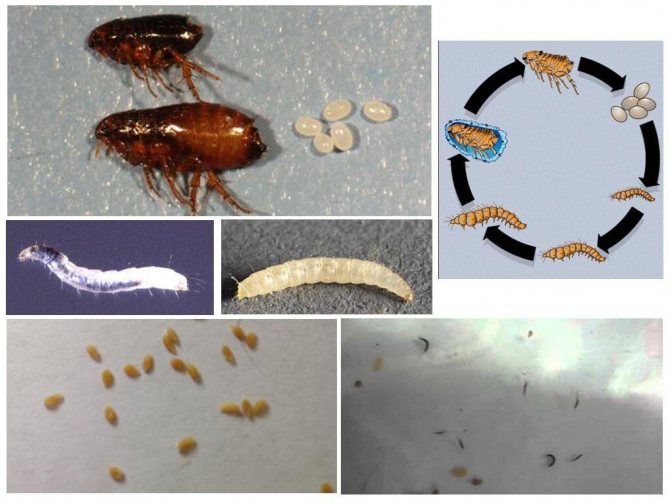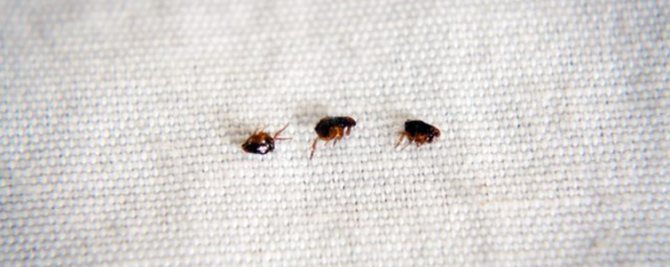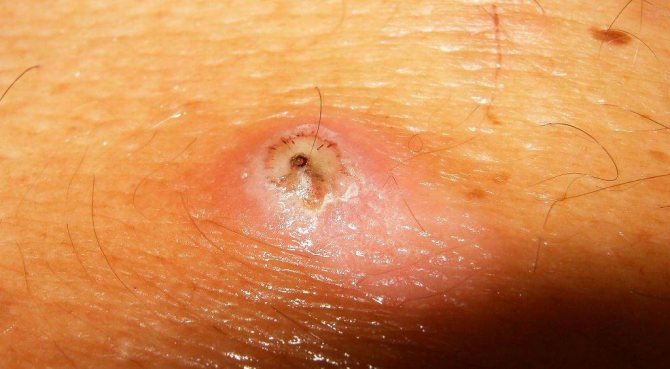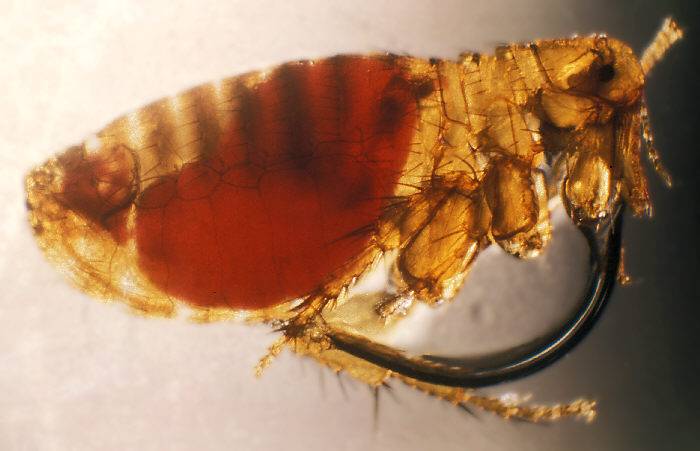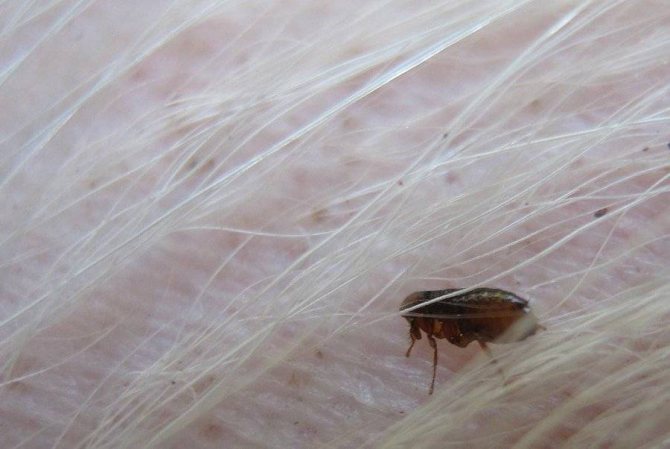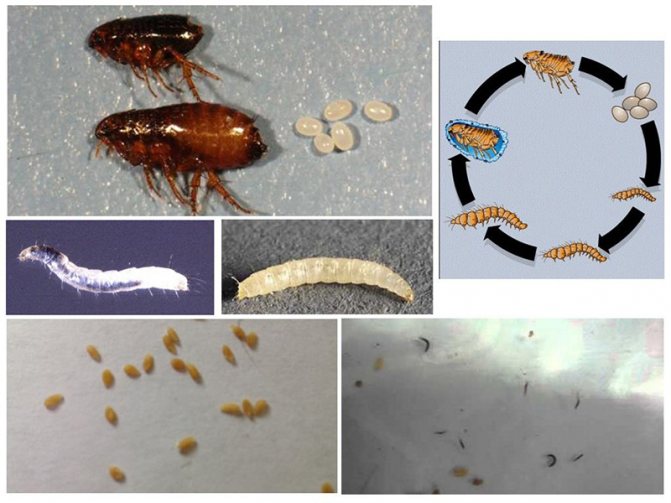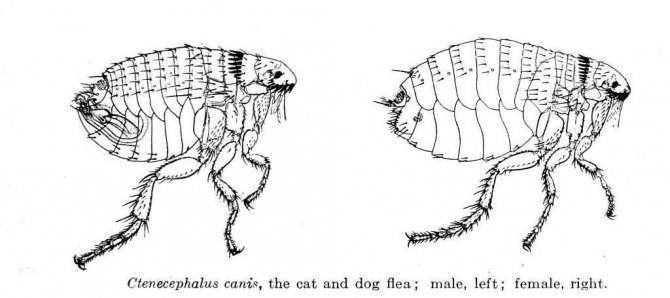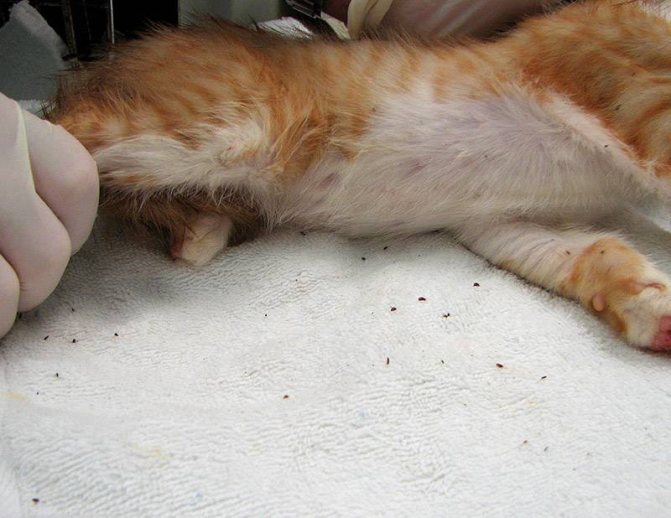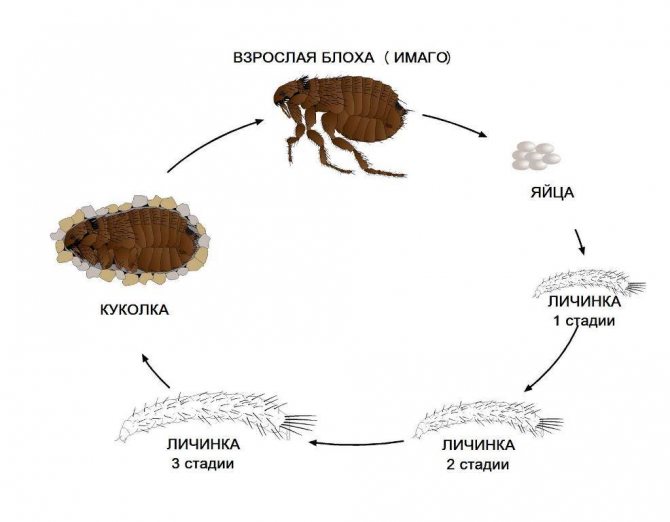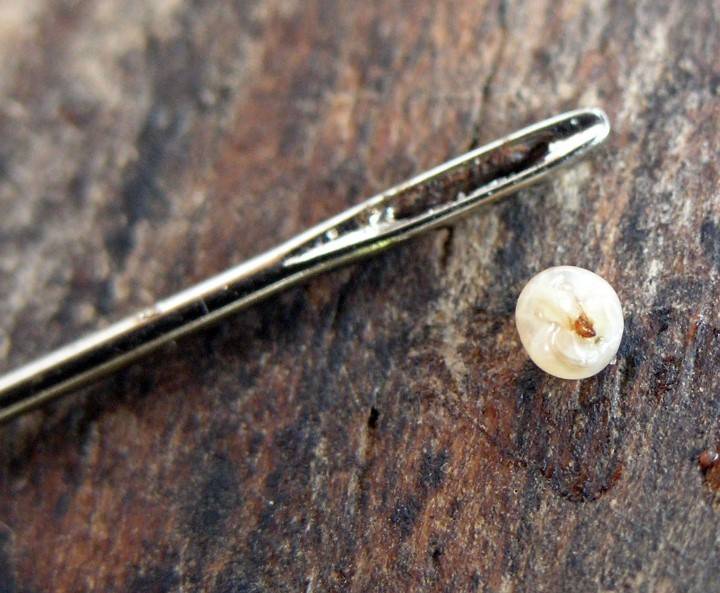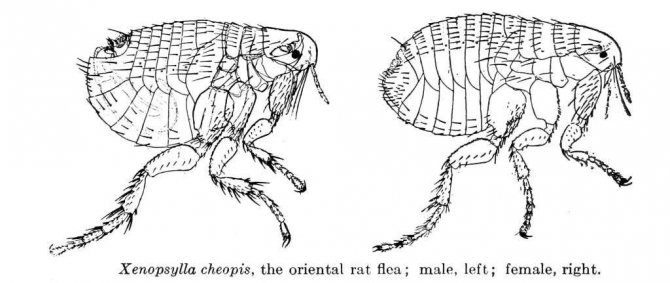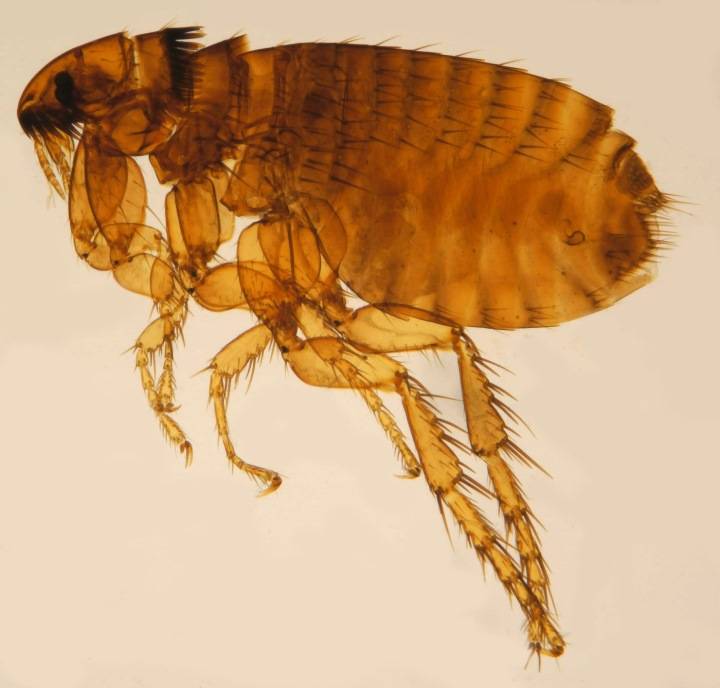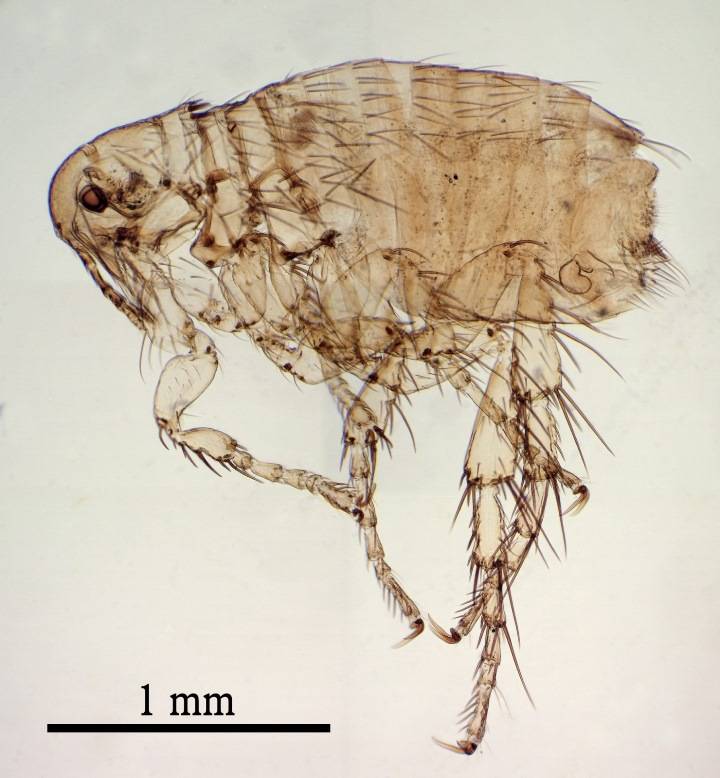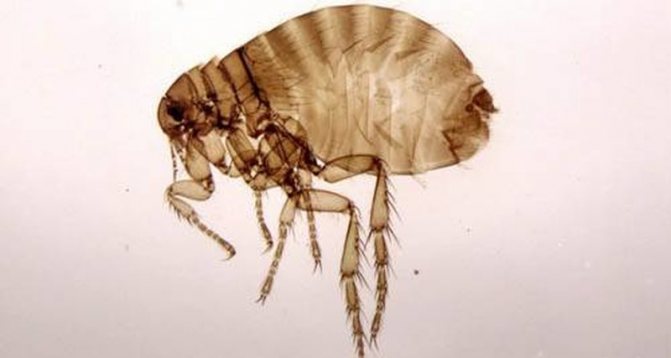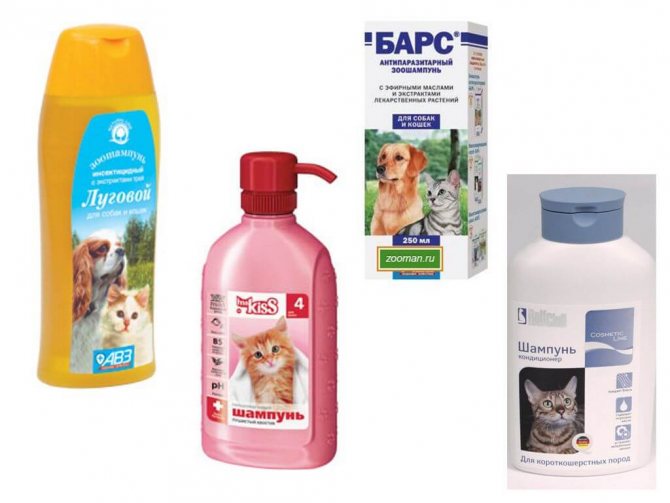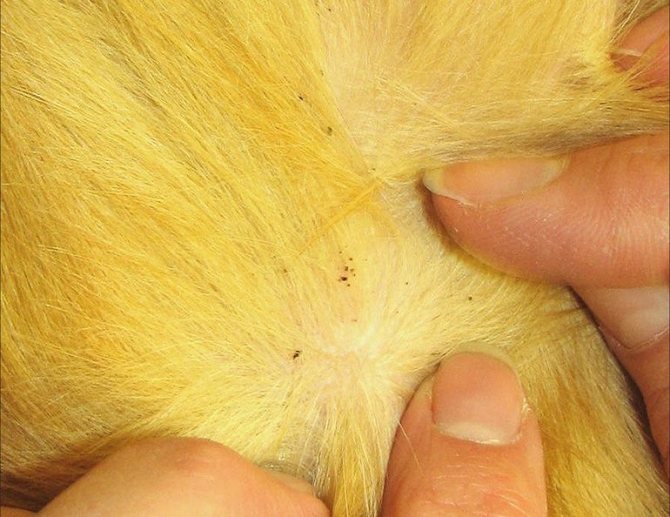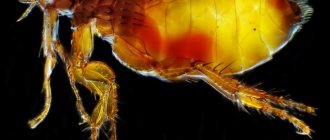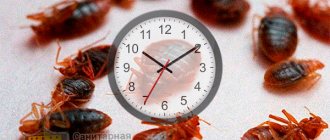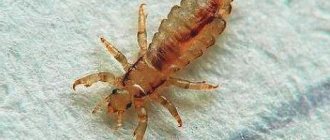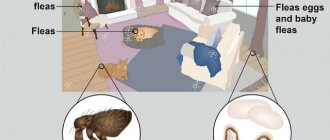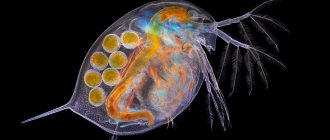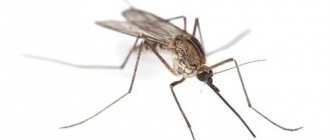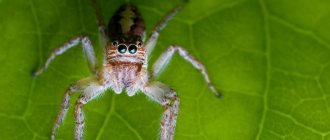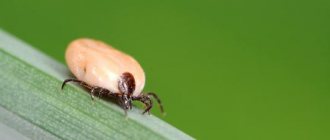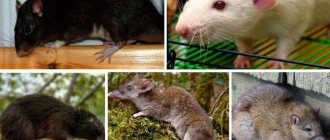Fleas are quite tenacious parasitic insects. But few people know how long fleas live without food, and how this data can help in their destruction. Many people believe that these insects live only under the fur of animals and feed on their blood. But not everyone knows where fleas live in their natural environment. Some types of parasites live in bird nests, hollows of squirrels, burrows of ground squirrels, mice, hamsters, foxes, hares, jerboas. A lot of parasites live on domestic artiodactyls. Fleas can be found on all continents of our planet, even in the permafrost of Antarctica. That is why for many people the presence of such parasites in the room is a big problem.
How long do fleas live in an apartment without animals?
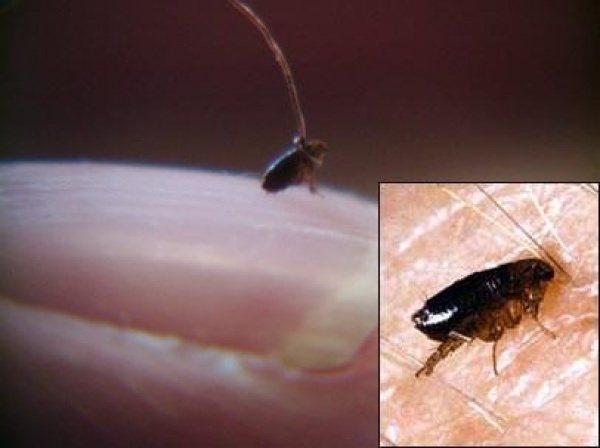


Fleas, settling in an apartment, spoil the life of not only pets, but also cause discomfort to humans.
There are more than 2000 species of these insects around the world. Basically, these are wingless blood-sucking parasites, with a flattened body on the sides and a small bristle on the body, with three pairs of paws. With the help of the back length of the pair, they have developed jumping ability. They are able to firmly adhere to the fur of animals. These parasites are troublesome. They are carriers of various dangerous infections. allergic reactions, are carriers of helminths.
How long do fleas live?
How many days does a flea live? Life expectancy depends on the temperature regime, air humidity and living conditions of an adult, on average - from 18 days to 3 months. During this time, the insect, on average, makes about a hundred bites on its prey.
In a lifetime, under ideal conditions, a female can lay up to five hundred eggs. No matter how comfortable the living conditions are, they often die from infections that they themselves carry, from the teeth of an animal, from the hands of a person or a disinfectant.
How long do fleas live without animals in an apartment?
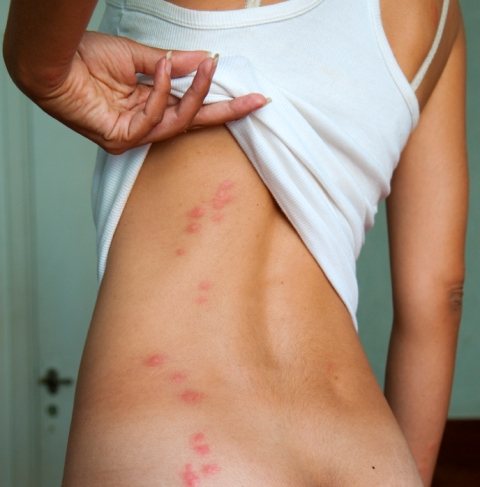

Can fleas live in an apartment without an animal? - the question is relevant, since not everyone has an idea where fleas come from, what they eat and how they reproduce.
For procreation, the female needs to lay eggs. It is impossible to do this without warm-blooded food, so their stay in housing where there are no pets is quite possible, because they can starve for a long time. This is not reflected in health, but the activity decreases somewhat. If there is a person in the apartment, insects can attack and feed on human blood, therefore, having found redness (mainly on the limbs) with a solid center, lined up in a row, one should think about the destruction of parasites by any of the known remedies or folk recipes.
If you leave with the animal for a month or two, the parasites will not die, but will calmly wait for your return. When leaving, you can treat the room with Dichlorvos, Karbofos or another disinfectant - such prevention will not only prevent their appearance, but also save the room from existing and hastily hidden fleas.
From folk methods against fleas, you can apply this option: scatter bunches of fresh herbs (wormwood, tansy, mint, eucalyptus) in the corners and hang in the closet and closet. Such herbs have a strong odor that fleas, bugs, cockroaches and other parasites are afraid of. You can also treat the surface of the accumulation of parasites with essential oils of these herbs.Then no parasite will wait for your arrival home, if it does not die, at best, it will run away in a half-dead state, for example, to a neighbor.
How long do fleas live in cats?
They jump on cats only to drink blood. The feeding process lasts from several minutes to an hour, consists mainly of one bite of a bloodsucker per day, taking into account that he was not frightened off. Otherwise, he can bite even as long as he does not satisfy his hunger. After a meal, the insect jumps off the animal and hides, as a rule, in the bedding of the fluffy one. Due to the presence of a large number of these insects, it seems that they live on an animal.
How long do fleas live without food?
Bloodsuckers can starve for a long time. They can easily go without food, for example, up to several months, while maintaining normal mobility. The only negative is that they cannot reproduce without food. Females will patiently wait for their prey for months to drink fresh blood and lay eggs. Sometimes they fall into a daze.
Such resistance of parasites is clear evidence that it is better not to joke with them and to apply the most effective measures when they are found in an apartment or on an animal.
Can fleas live in clothes and couches?
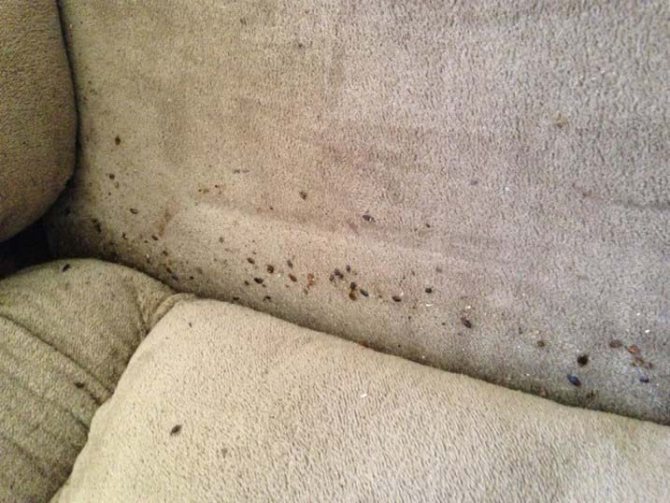

The favorite habitats of parasites in the apartment are sofas, carpets, clothes, bed linen. They settle behind the plinth and in the crevices of the walls. One of the most beloved habitats is rugs for domestic animals (cats and dogs). They love comfort, especially they prefer natural warm pile - an ideal breeding ground. Here you can also sit out after saturation. In ancient times, the rich made traps: they hung pieces of natural wool on the skin of their legs to lure, then they burned them, along with the accumulated parasites.
The life cycle of feline fleas
Feline fleas are the closest relatives of canine, chicken and rat parasites. They differ only in appearance and in their size, so it is difficult for an unknowing person to understand the variety of these insects. But not everyone knows how problematic fleas can be in cats and how difficult it is to get rid of them.
Basically, the flea is considered one of the most common parasites of furry animals. Moreover, cats and cats are not always the main object of attention of the insect, but only the main source of food. They simply hop on top of the animal to get their blood and then leave the object and hide in various places to lay their eggs.
Cat fleas are quite small insects compared to dog fleas. Their body length can range from 0.8 to 4 mm. They do not have wings, but are equipped with powerful hind legs, which provide them with the ability to jump sufficiently long distances. Thanks to this feature, parasites can quickly and easily jump from one object to another.
Such a flea lives in places of large accumulation of debris, in the grass, under stones, in holes and nests of animals. Many species of such parasites can starve for a long time, and the blood of animals is necessary for them to prolong the genus. A female sated with blood can begin to lay eggs in just a few hours.
Where do fleas live in nature?
Fleas have been very common in nature since ancient times. They live in the nests of birds, squirrels. In earthen holes (foxes, jerboas, ground squirrels, hamsters, gerbils and other rodents). On artiodactyls. There are species that live under the skin of mammals. Parasites are found in the countries of Asia, Africa, on all continents of the earth (even in Antarctica). They can be seen in water and sand.
Some species are breaking records for survival. Parasitizing northern animals, they can go into prolonged hibernation in the winter season and live more than a year on average.
Prevention of fleas in the apartment
Prevent blood-sucking insects from breeding. Frequent wet cleaning, with the addition of special chemicals.Frequent washing of linen and ironing with a hot iron. We vacuum carpets, sofas. We treat with a special spray, powder in the corners and behind the skirting board. Treat pets by your veterinarian or yourself. All this will help get rid of these annoying insects forever. And improve the quality of life of yourself and your pets.
Disinsection
The life span of a flea, even under favorable conditions, is about 3 months - during this time it will have time to cause a lot of trouble. Therefore, you need to quickly purchase a special spray for blood-sucking pests. The standard packaging is designed to cover an area of about 10 squares. You can carry out pest control yourself or with the help of a service that deals with the processing of apartments.
- It is necessary to spray the product especially carefully in those places where fleas live. These are gaps in the floor, hard-to-reach places behind furniture, areas behind skirting boards, etc. After processing, the room is left for at least 2 hours.
- The floor should not be washed for at least 5 days. A flea nest, wherever it is, will suffer, but the eggs will be intact. After a few days, larvae will emerge from them, which will die only after falling on the treated surface. If, 3 weeks after the disinfestation, the insects are still jumping, the procedure should be repeated.
What types of fleas can live in the house
Almost all of the listed species of fleas can live in a person's dwelling, with the exception of the last three. They feed on human and pet blood. Fleas are carriers of dangerous viral diseases, parasites, skin infections. The average life span of these insects is 2-3 months.
Fleas are most commonly found in the following locations:
- bedding and beds for pets;
- carpets and coverings with pile;
- sofas, armchairs;
- linens;
- cracks in walls and floors;
- skirting boards;
- old stuff, rubbish.
In addition, almost all types of fleas living in the house can live in the coat of a dog or cat. They do not live on humans.
How do you know if your pet has fleas?
In the early stages, it is quite difficult to notice insects, but after a long time, you can notice clear signs of the presence of fleas in your home.
You can immediately notice insects, if your cat begins to be allergic to their bites, then all the signs of the disease will begin to appear immediately, and every day the pet will become worse and worse if you do not start removing fleas from your pet's fur.
Unlike bedbugs, fleas do not inject an anesthetic substance into the body during a bite, so if your pet suffers from insomnia very often, then this is a sure sign that fleas are in your apartment.
In the later stages of insect infestation, the pet begins to strongly scratch the wounds that remain after flea bites. Soon ulcers begin to appear on the animal's body, and there is a risk of introducing a dangerous infection into the bloodstream.
In places where fleas are most common, a dog or cat may begin to lose hair. To find out if your pet has fleas, plant it on a white sheet of paper and comb it thoroughly. If black dots appear on the paper, then this is nothing more than flea feces, and you should no longer have any doubts about the presence of insects in the house.
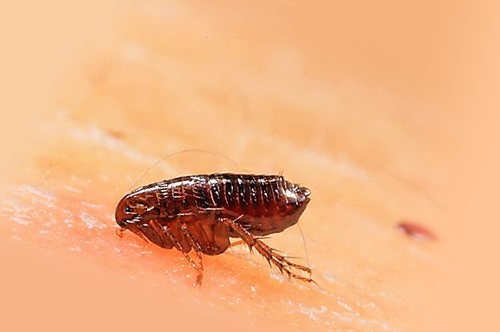

The photo shows a flea.
Very often fleas like to settle in places that are not accessible to your normal eyes. Therefore, start examining your pet in the area near the tail and near the belly. Run your hand over the fur, slightly pushing it apart, to notice insects parasitizing the animal's skin.
What house fleas look like and how to spot them
The flea is a small blood-sucking insect, the size of which does not exceed 3 mm.These parasites in appearance resemble very small, round and shiny plant seeds. The color of an adult insect is black or dark brown. All flea species differ in size, but these differences are very small.
Almost every person with a pet knows what adult fleas look like. However, few have seen flea larvae. So, let's take a closer look at the life cycle of an insect.
In its reproduction, a flea goes through a full cycle of successive transformations - an adult insect, an egg, a larva, a pupa, an adult insect.
Flea eggs look like tiny white translucent balls. A single female can lay up to 30 eggs per day. After two weeks, larvae appear from the eggs, resembling a small black worm. The worms actively move and live in dust, debris, or in the bedding of a pet. Then the larva pupates and increases in size. Further, an adult flea emerges from the pupa.
Fleas are difficult to spot. The determining factor is the presence of them on the pet. If there is neither a cat nor a dog in the house, then it is quite difficult to find out where fleas live and whether they exist at all.
Life expectancy in vivo
Among the natural ones, the existence of a parasitic organism on the body of the carrier (animal) is distinguished. Pests occur if the pet does not wash itself periodically or the owner does not provide regular washing and cleaning of the coat. The parasite lives for about two weeks.
To calculate the maximum term, the animals were put on special collars that did not allow the pets to take care of themselves. In this case, the life span of a flea reached 120 days. Females turned out to be tenacious.
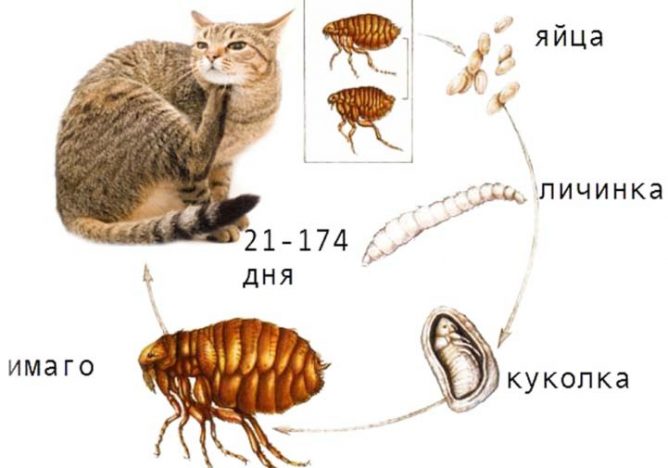

Where do fleas come from in the house?
It is generally accepted that fleas appear in the apartment from pets that carry them on their fur. However, this statement is absolutely not true. Where do fleas come from in the apartment?
Their eggs and larvae can enter the house along with the soil brought on shoes, adult insects can enter the living space from the attic, from the basement or from the entrance. If they are not noticed in time, they will multiply quickly and over time will turn into a huge problem. For this reason, if at least one individual is found, it is necessary to treat the entire apartment and pets from fleas in a short time.
To understand where fleas appeared in the apartment and how to get rid of them, it is necessary to thoroughly examine all the nooks and crannies of the home. It should be remembered that these insects prefer contaminated areas away from sunlight. Wet and dusty rooms attract them the most.
After examining and detecting flea larvae, their eggs or adults, it is necessary to process the premises as soon as possible. A very good effect is given by various insecticidal agents that can be purchased at a veterinary pharmacy or pet store. Excellent results are shown by "Entomozan" - at a very affordable cost, it is completely safe for animals and humans, has almost no odor and perfectly eliminates fleas.
Proper flea treatment includes cleaning floors and walls, and destroying old clothing and unnecessary rags. In addition, it is necessary to get rid of fleas of all pets. Modern science offers an extensive range of all kinds of products for cats, dogs and other pets. The preparations "Bravecto", Frontline Nexgard "," Stronghold "in combination with anti-flea collars have a particularly good effect. Such funds will help to reliably protect the pet from any blood-sucking insects for up to 6 months.
IMPORTANT. When treating an apartment from parasites, remember that fleas can jump high. For this reason, it is necessary to thoroughly spray with the preparation not only the floor, but also the walls to a height of 1 m, pay special attention to the existing cracks and cracks.
How quickly do fleas die during treatment?
So, if you want to find a flea habitat, look indoors. Most often this is your pet's bedding, carpets, upholstered furniture, dusty corners and secluded places behind the baseboard, cracks in the floor. Here you can often find larvae that look like worms.
But in clothes they are infrequent guests. They settle in the closet only when there is a large population of the room with parasites. They love places from which you can quickly get to the main food source - the animal.
With proper treatment with insecticides, fleas die in 1-2 days. It is important to start by treating the room and then treat all pets. Remember that insecticide will not penetrate deep into the carpet. But it is there that the accumulation of eggs, larvae, and numerous pupae is located. A durable cocoon protects pupae from the most powerful chemicals.
This is why it is so important to re-treat the room. It is performed a few days after the main one.
It is better to use long-acting insecticides. Even adults that emerge from cocoons after 3-4 weeks die from them. Remember that the properties of drugs weaken over time. Re-processing is necessary after 2-3 weeks. To remove the entire home colony, 2-3 high-quality treatments are required.
What do fleas eat and how long do fleas live without food?
Fleas feed exclusively on the blood of humans and warm-blooded animals. This naturally leads to the question - how long will a flea live without food if there is no food source nearby?
Like the vast majority of parasites, fleas, under unfavorable conditions, fall into suspended animation, in which they can stay for a very long time. In the absence of a regular intake of food in the insect's body, they lose their ability to reproduce, but they themselves do not die. In the same way, pupae and flea larvae fall into suspended animation. Therefore, you should not expect favors from nature, it is better to try to get rid of intruders as soon as possible.
What determines the life span of fleas
The duration of a flea's existence is influenced by a number of factors at once:
- Ambient temperature and humidity. With low humidity and temperature, bloodsuckers will live longer than with high temperatures.
- The constancy of the state of the environment. If the temperature jumps frequently, the parasites go into a state of daze. Thanks to him, bloodsuckers live longer.
- Food. If a flea is starving, it will live even longer.
A flea is primarily a parasite. Nature provides that their reproduction depends not so much on the timing, speed, but on how many offspring each female will bring out. Do not hope that in your home such an important reproduction process will somehow stop itself.
It is important to poison these parasites totally. It is necessary to destroy both adults and larvae, egg clutches. Only then can we hope that the parasites will disappear completely.
How long do bloodsuckers live?
The question of how long fleas live is asked by those who once discovered parasites in their pet's fur or felt the bites of pests on their bodies. In the presence of favorable living conditions, pests are able to live for about three months, having time to inflict up to a hundred bites on their prey during this time, while females can lay up to 500-600 eggs during this period. The following factors have a significant effect on the life span of insects.
Temperature
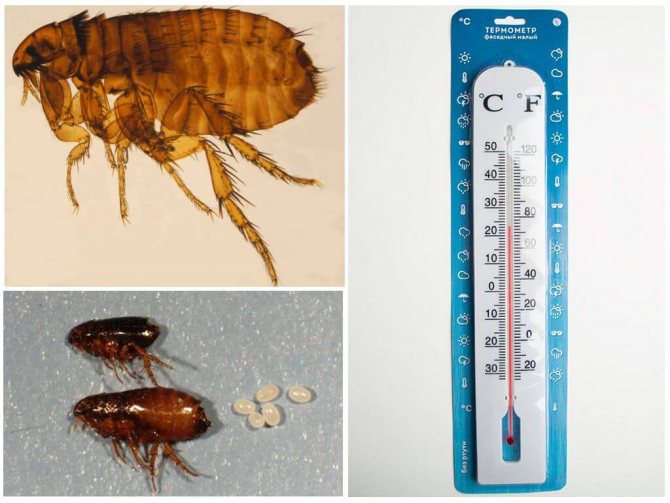

Influence of temperature on the life of parasites
An increase in temperature norms helps to shorten the development cycle of the insect. Moreover, in this case, adults have larger dimensions than relatives growing in favorable conditions. So if, under optimal conditions, the process of larval formation takes about a month, when the temperature rises, it takes no more than 7 days,eggs develop within two weeks and the insect spends the same amount of time in the pupal phase.
The maximum upper temperature limit at which pests can live is +45 degrees. That is why insects do not survive after processing an apartment with a steam generator or fan heater.
With a decrease in temperature, the formation of the egg and the development of the larva stretch for 8 months, and therefore, the life span of the flea also increases to 1-1.5 years. But:
- at a mark of -10 degrees, insects become incapable of reproduction;
- at rates below -14 degrees, fleas simply cannot live;
- for the larvae, the temperature below +10 degrees is fatal.
Humidity
Humidity is another factor that affects a flea's lifespan. Insects will live longer in damp areas. It is for this reason that fleas often live in the basements of apartment buildings, where leaks of engineering communications are a very frequent occurrence.
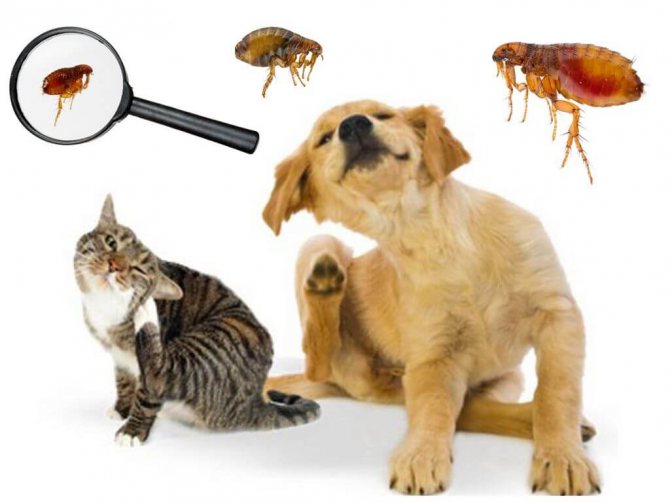

Fleas on animals
The flea is a rather whimsical insect for food, which feeds only on fresh blood. The parasite will not live on a host that has died suddenly and will quickly leave the body of the dead animal.
Parasites and microorganisms
Natural enemies (parasitic ticks, red pharaoh ants, various bacteria, fungi and nematodes) have no less influence on the life span of fleas.
Insecticidal preparations
The destruction of adults, as well as their larvae, is also facilitated by the use of insecticidal agents. When exposed to pesticides, pupae slow down the metabolic process, as a result of which they leave their cocoons 2-6 months later than usual.
Of all flea species, insects that parasitize northern animals are recognized as centenarians. In severe frosts, they fall into a long numbness and are able to live for a total of more than 1.5 years.
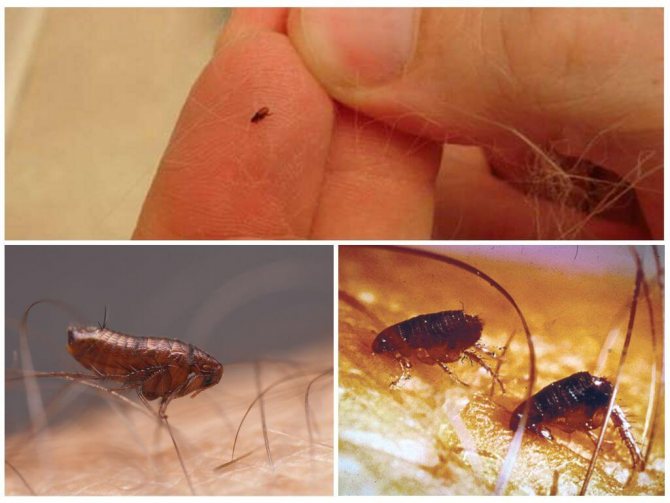

Control methods
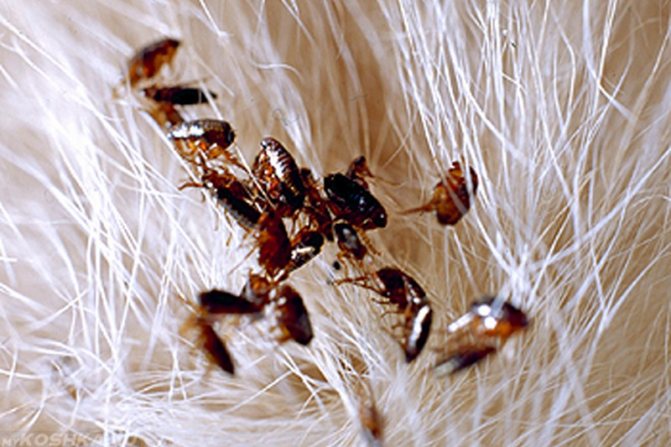

Our service works in the basements of apartment buildings, which are sources of flea breeding in modern cities, and also treats apartments and private houses from fleas. We carry out disinsection against fleas in residential premises by large-drop spraying, using mainly emulsion insecticides, microencapsulated agents. Floor coverings, furniture and walls are processed to a height of 1 - 1.5 meters from the floor, including bedding on which pets sleep
We suggest that you familiarize yourself with How to remove fleas from a cat at home, folk remedies, how to remove from an apartment
After the procedure, it is important to maintain the effect of the drug on the entire surface of the floor covering, refusing to wet cleaning until the insects disappear. After the expiration of the product, it is necessary to carry out a general cleaning
The funds are provided with accompanying documents confirming their safety and effectiveness. The choice of the form of the funds depends on many factors:
- ease of use
- object type and conditions
- the number and population composition of fleas
- terms of application, holding of the product and its subsequent cleaning
- pest control safety requirements
For example, in houses with long-term settlement, in which fleas have been breeding for more than one month, as a rule, up to 95% of the population size are preimaginal stages of fleas - worm-like larvae, pupae, eggs. In this case, bio-drugs are prescribed, such as insect growth regulators.
Under the influence of such means, flea larvae die during the transition to the next stage, and from the treated pupae fleas with organic defects appear, which die soon after emerging from the cocoons. At first, this noticeably slows down the rate of flea reproduction, and after 1-2 months, it massively reduces the number of eggs, larvae and pupae of fleas in the room.
Also, if the absence of odor is important during processing, oil-water-based preparations, microencapsulated funds are prescribed.If the ingress of moisture during processing is undesirable, dusts are used. At facilities where the minimum exposure time of the agent is ensured (with daily washing and cleaning), sharp action agents are used. In other places where the agent retains its effect, there are long-acting drugs, including microencapsulated and powdery agents.
If you do not plan to spend money on such services or do not trust the services, then with the right approach, you can take fleas out of the apartment yourself.
- clean your animal, flooring and furniture from fleas using low-toxic insecticides, and also use available natural remedies in parallel.
- clean the house using chemical insecticides (if there are no animals in the house).
Insect settlement sites
The flea nest can be located in dark hidden places where no one will disturb the insects and it will be easy for them to reach the victim. Parasites can settle in pet bedding, carpets, in the crevices of baseboards and floors. They can also live in a pile of rubbish gathered in a corner. There, bloodsuckers spend most of their lives, giving birth to new offspring.
Therefore, even one flea seen in a cat or dog is cause for concern. After all, the parasite is able to live outside the animal for several months, and most likely a whole family of bloodsuckers can stay somewhere nearby. The situation is further complicated when considering how quickly the pests reproduce, carrying serious diseases. That is why decisive measures should be taken urgently to get rid of fleas.
Extreme conditions in the life of the parasite
These conditions include:
- Frost and cold. Low temperatures are destructive. Imagoes die at this time of the year already five days after birth. The minimum air temperature of potential death is only a couple of degrees above zero. The parasite cannot survive on the street without its own host.
- Heat and dryness. The minimum temperature that can kill the pest is around 35 degrees Celsius. A slight deviation of the moisture index from the standard can cause the death of the parasite after two days. The larvae die before they even have time to form.
Fleas do well in standard temperature conditions, where it is neither cold nor hot.
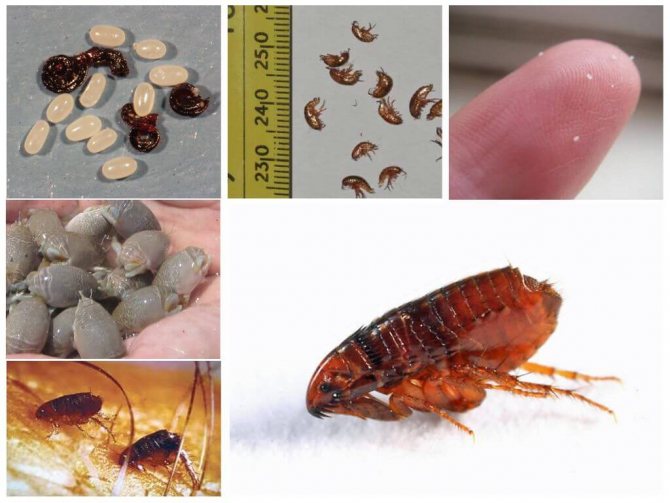

Where do fleas come from and how to get rid of them
Fleas Are blood-sucking insects that parasitize warm-blooded animals and humans. As well as cockroaches or bed bugs, fleas have annoyed people and pets since the beginning of time. It was domestic animals that in most cases infected the home with these small bloodsucking insects.
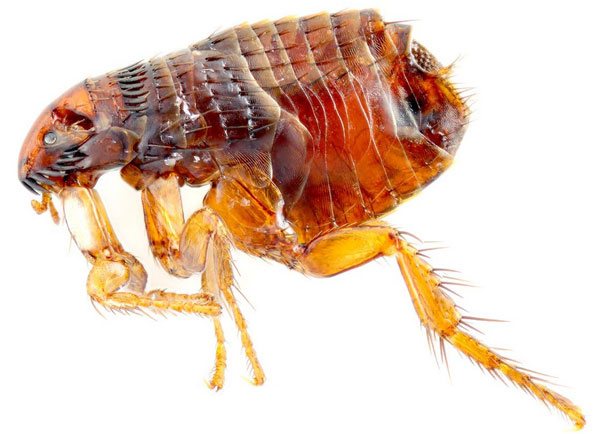

There are about 2000 species of fleas in the world. Each species is adapted to its host, that is, the host, whose blood they will feed on and reproduce on his own body.
Most often in St. Petersburg the following types of fleas are found:
But that doesn't mean that cat flea will not bite a person, but on the contrary, will drink human blood with pleasure.
How to protect yourself
Now it has become finally clear that fleas are transmitted from cats to humans, and this happens quite often. But you can protect yourself from infection if you follow some rules:
- You should not be in close contact with stray animals. So do not pet stray cats and do not come close to them, fleas can quickly jump on you.
- If you have a pet, check its body regularly. But even such inspections will not be enough. If a pet goes outside, then you should periodically treat it with specialized preparations or, for example, use a flea collar.
- If parasites were found on an animal, then a person should treat not only it, but also the dwelling.
- If you are forced to often or constantly contact animals (this applies to veterinarians, nursery workers), then, firstly, regularly examine your body, and secondly, for preventive purposes, use specialized insecticidal preparations that destroy pests.
The parasites are transmitted from cats to humans and bite humans, but you can try to protect yourself from their attacks.
Where do fleas come from in an apartment and how to get rid of them?
Fleas in an apartment turn out to be different ways. In the overwhelming majority of cases, fleas are brought into the apartment by pets - dogs and cats. Even an escaped hamster or rat can return home with parasites if the front door in the house is dirty and the basement doors are open.


The main ways of spreading fleas:
- Contacts of pets on the street with stray animals. Contact with other pets that are already infected with fleas. Most fleas living in big cities do not care who will be the source of food - a cat or a dog, so they are easily transmitted from dogs to cats and vice versa.
- Courtyard lawns in summer. In the warm season, fleas actively reproduce and lay eggs, which often, along with wool or in contact with grass or shrubs, fall into the grass, where they are picked up by non-infected animals - on their paws or wool, they are brought home.
- Basements of houses... Warm and damp basements where rats, mice, stray cats, homeless people live, and take off and basement fleas... If you do not pay due attention to cleanliness in the house, then fleas will successfully spread to the entrance, and then on their own, in the fur of animals, on people's clothes, they will get into apartments.
Flea lifespan
How long fleas live will depend greatly on the conditions of their existence. Insects are very unpretentious, but in unfavorable conditions their life cycle is reduced and disrupted. In order for the parasite to spend an average life span (60-90 days), lay up to 500 eggs and eat at least 60-100 times, it needs the following habitat parameters:
- For rat fleas - humidity 60%, temperature 14-15 degrees
- For chicken fleas - humidity 80%, temperature - 20-25 degrees
- For fleas, dogs and cats - humidity 60%, temperature - up to 25 degrees
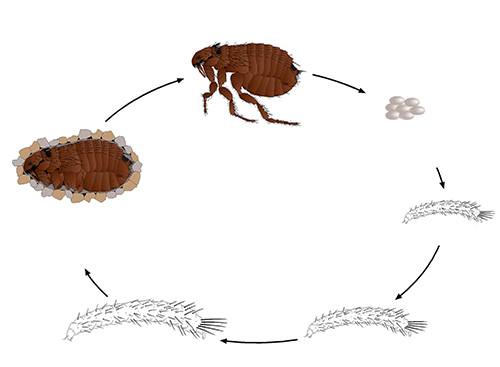

At the end of the specified period, the out-of-date flea dies of old age. The life span of a flea, even with constant access to food, decreases with increasing temperature. For example, at temperatures above 35 degrees, they can exist for only a month, respectively, they will have time to lay much fewer eggs, but they grow incredibly large. On the contrary, if the ambient temperatures are lowered, the life span of a flea increases to 1.5-2 years, but the insects become much smaller.

